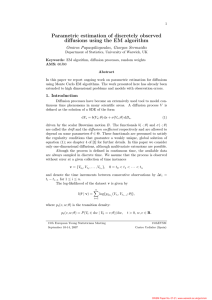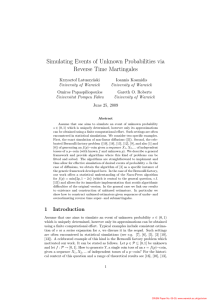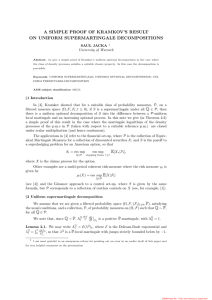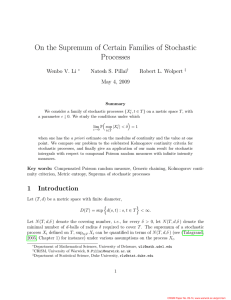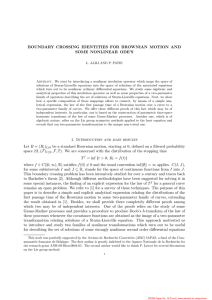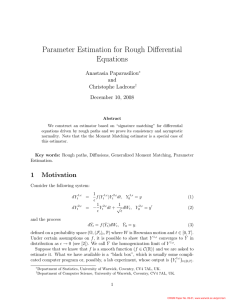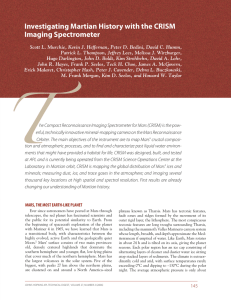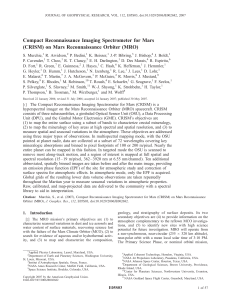STRUCTURAL AND GEOLOGIC RELATIONSHIPS BETWEEN IGNEOUS ROCKS AND THEIR
advertisement
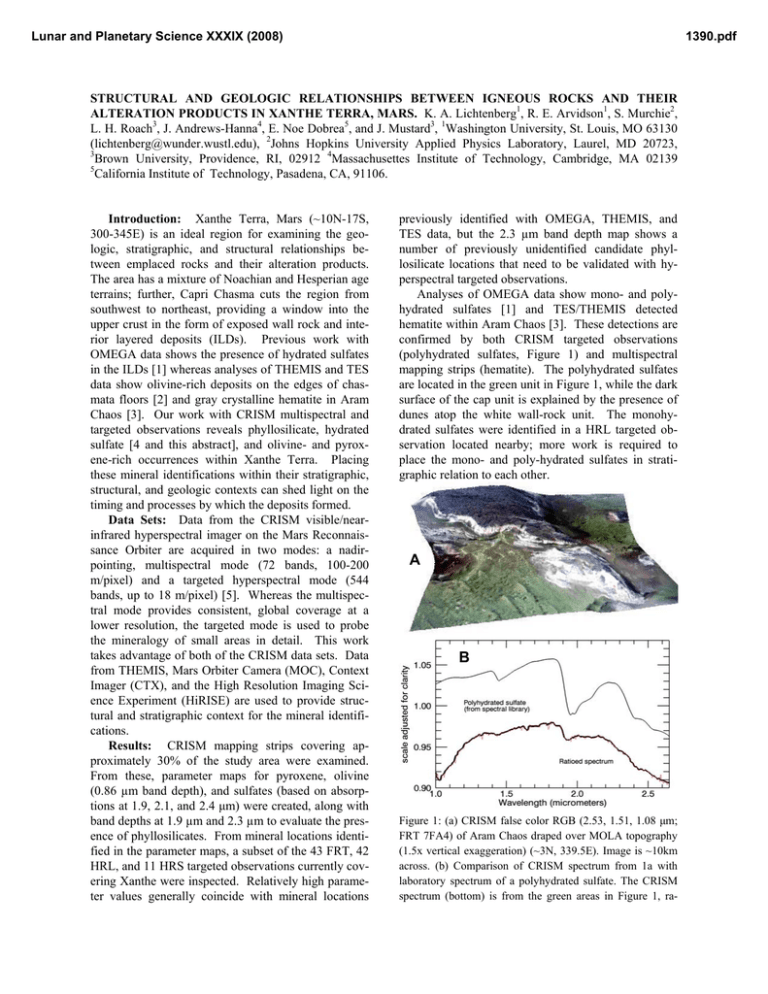
Lunar and Planetary Science XXXIX (2008) 1390.pdf STRUCTURAL AND GEOLOGIC RELATIONSHIPS BETWEEN IGNEOUS ROCKS AND THEIR ALTERATION PRODUCTS IN XANTHE TERRA, MARS. K. A. Lichtenberg1, R. E. Arvidson1, S. Murchie2, L. H. Roach3, J. Andrews-Hanna4, E. Noe Dobrea5, and J. Mustard3, 1Washington University, St. Louis, MO 63130 (lichtenberg@wunder.wustl.edu), 2Johns Hopkins University Applied Physics Laboratory, Laurel, MD 20723, 3 Brown University, Providence, RI, 02912 4Massachusettes Institute of Technology, Cambridge, MA 02139 5 California Institute of Technology, Pasadena, CA, 91106. Introduction: Xanthe Terra, Mars (~10N-17S, 300-345E) is an ideal region for examining the geologic, stratigraphic, and structural relationships between emplaced rocks and their alteration products. The area has a mixture of Noachian and Hesperian age terrains; further, Capri Chasma cuts the region from southwest to northeast, providing a window into the upper crust in the form of exposed wall rock and interior layered deposits (ILDs). Previous work with OMEGA data shows the presence of hydrated sulfates in the ILDs [1] whereas analyses of THEMIS and TES data show olivine-rich deposits on the edges of chasmata floors [2] and gray crystalline hematite in Aram Chaos [3]. Our work with CRISM multispectral and targeted observations reveals phyllosilicate, hydrated sulfate [4 and this abstract], and olivine- and pyroxene-rich occurrences within Xanthe Terra. Placing these mineral identifications within their stratigraphic, structural, and geologic contexts can shed light on the timing and processes by which the deposits formed. Data Sets: Data from the CRISM visible/nearinfrared hyperspectral imager on the Mars Reconnaissance Orbiter are acquired in two modes: a nadirpointing, multispectral mode (72 bands, 100-200 m/pixel) and a targeted hyperspectral mode (544 bands, up to 18 m/pixel) [5]. Whereas the multispectral mode provides consistent, global coverage at a lower resolution, the targeted mode is used to probe the mineralogy of small areas in detail. This work takes advantage of both of the CRISM data sets. Data from THEMIS, Mars Orbiter Camera (MOC), Context Imager (CTX), and the High Resolution Imaging Science Experiment (HiRISE) are used to provide structural and stratigraphic context for the mineral identifications. Results: CRISM mapping strips covering approximately 30% of the study area were examined. From these, parameter maps for pyroxene, olivine (0.86 µm band depth), and sulfates (based on absorptions at 1.9, 2.1, and 2.4 μm) were created, along with band depths at 1.9 µm and 2.3 µm to evaluate the presence of phyllosilicates. From mineral locations identified in the parameter maps, a subset of the 43 FRT, 42 HRL, and 11 HRS targeted observations currently covering Xanthe were inspected. Relatively high parameter values generally coincide with mineral locations previously identified with OMEGA, THEMIS, and TES data, but the 2.3 µm band depth map shows a number of previously unidentified candidate phyllosilicate locations that need to be validated with hyperspectral targeted observations. Analyses of OMEGA data show mono- and polyhydrated sulfates [1] and TES/THEMIS detected hematite within Aram Chaos [3]. These detections are confirmed by both CRISM targeted observations (polyhydrated sulfates, Figure 1) and multispectral mapping strips (hematite). The polyhydrated sulfates are located in the green unit in Figure 1, while the dark surface of the cap unit is explained by the presence of dunes atop the white wall-rock unit. The monohydrated sulfates were identified in a HRL targeted observation located nearby; more work is required to place the mono- and poly-hydrated sulfates in stratigraphic relation to each other. A B Figure 1: (a) CRISM false color RGB (2.53, 1.51, 1.08 μm; FRT 7FA4) of Aram Chaos draped over MOLA topography (1.5x vertical exaggeration) (~3N, 339.5E). Image is ~10km across. (b) Comparison of CRISM spectrum from 1a with laboratory spectrum of a polyhydrated sulfate. The CRISM spectrum (bottom) is from the green areas in Figure 1, ra- Lunar and Planetary Science XXXIX (2008) tioed to a spectrally featureless area within the observation. Ferric oxides may also be present in the CRISM spectrum, consistent with observations by Bibring et al. [6] FRT 8236 (Figure 2) shows that phyllosilicate signatures consistent with nontronite or saponite are associated with a Noachian-age crater (~8.5S, 305E). At this stage, identifications of phyllosilicates in the Xanthe area are confined to Noachian-age terrain, consistent with the hypothesis set forth by Bibring et al. [7] 1390.pdf CRISM detections of olivine within Xanthe Terra are primarily located in high thermal inertia areas on the chasma floors. An example detection is shown in Figure 3. Examination of FRT 586D over Noachian age plains in Xanthe Terra shows negative spectral slopes between 1 and 2.65 μm and absorptions indicative of pyroxene (consistent with dust over basaltic material [11]), while examination of FRT 4A9A over Hesperian age plains shows only a highly dusty surface. A B Figure 3: Locations of olivine-rich material (~3S, 326E) identified from CRISM multispectral data using the 0.86 μm band depth map overlain on THEMIS daytime IR. Figure 2: (a) CRISM false color RGB (2.53, 1.51, 1.08 μm) of a Noachian-age crater (~8.5S, 305E) draped over MOLA topography (1.5x vertical exaggeration). Image is ~10km across. (b) Comparison of CRISM spectrum from 2a with a laboratory spectrum of a phyllosilicate, nontronite. The CRISM spectrum (top) is from the green areas in 2a, ratioed to a spectrally featureless surface. The sulfate multispectral parameter map shows hydrated sulfates within ILDs in Capri Chasma and within wall rocks of Ganges Chasma. Both of these are consistent with OMEGA detections [1,8]. Analysis of targeted observations and HiRISE data of ILDs in Valles Marineris [9] shows layering of mono- and poly-hydrated sulfates. The detections in Capri and Ganges Chasmata will be validated with targeted observations as they become available in order to probe potential layering and distinguish between mono- and poly-hydrated states. Consistent with previous THEMIS, TES, and OMEGA identifications of olivine-rich material [2,10], Implications: Recent work on groundwater modeling [12,13] shows that low areas in the north-east portion of Xanthe Terra, including Aram and Iani Chaos would have had high hydrostatic heads and therefore could have experienced high evaporation rates during periods of groundwater recharge. These areas show strong hydrated sulfate signatures, suggesting that the minerals in these areas were likely formed by accumulation of evaporites and groundwater alteration of previously extant rocks. References: [1] Gendrin A. et al. (2005) Science, 307. [2] Edwards, C. S. et al. (2007) 7th Int. Conf. on Mars, Abstract #3280. [3] Glotch T. D. and Christensen P. R. (2005) JGR, 110. [4] Lichtenberg K. A. et al. (2007) Eos Trans. AGU, 88(52). [5] Murchie S. et al. (2007) JGR, 112. [6] Bibring J. P. et al. (2007) Science, 317. [7] Bibring J. P. et al. (2006) Science, 312. [8] Mangold M. et al. (2007) 7th Int. Conf. on Mars, Abstract #3141. [9] Roach L. et al. (2008) LPSC XXXIX, this issue. [10] Gondet B. et al. (2007) 7th Int. Conf. on Mars, Abstract #3185. [11] Lichtenberg K. et al. (2007) JGR, 112. [12] Andrews-Hanna J. & Zuber M. (2008) LPSC XXXIX, this issue. [13] AndrewsHanna J. et al. (2007) Nature, 446.

